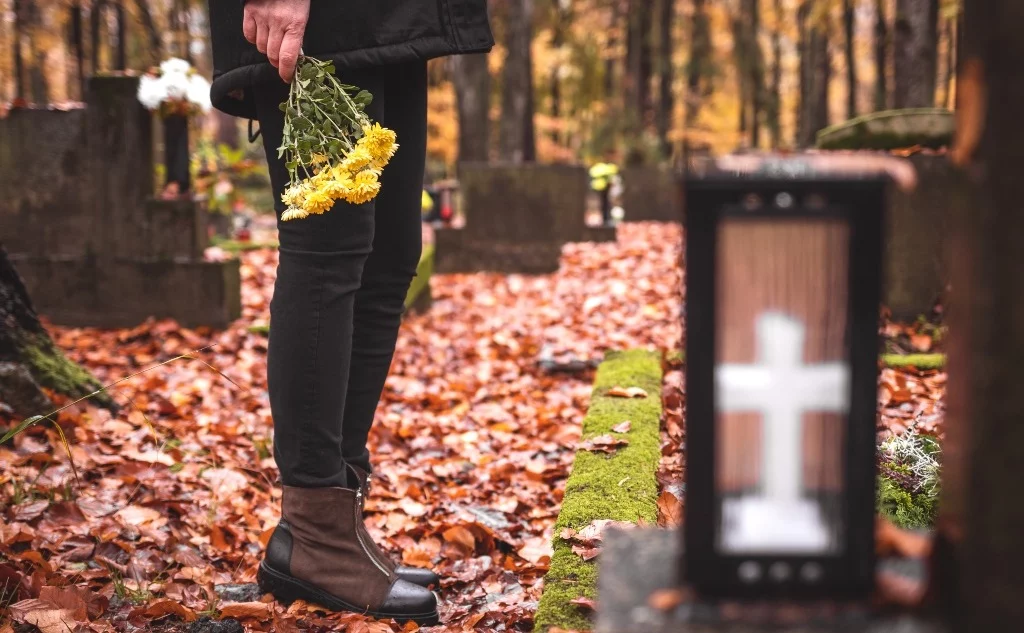Here’s what the Epitaph poetry form is:
An epitaph is a short inscription on a tombstone meant to honor someone who has passed.
An epitaph is usually a meaningful poem or prose commissioned by the family of the deceased.
So if you want to learn all about the Epitaph poetry type, then you’ve come to the right place.
Let’s get right to it!

Forms of Poetry: The Poetic Epitaph

An epitaph is a short text meant to appear on a tombstone.
Epitaphs can either be intended as prose or as poetry.
They have appeared in burial traditions at least as far back as ancient Egypt.
The majority of epitaphs describe the deceased in some way, honoring their memory by defining their life with its titles or achievements.
An epitaph can technically be any text meant for a tombstone, however, and is usually commissioned by the family, prepared by a loved one, or even provided posthumously by the deceased’s records.
It is not uncommon for poets, in particular, to write their own epitaphs when they feel they’re nearing the end of their life.
Basic Properties of the Epitaph

| Rhyme Structure | Varies |
| Meter | Varies |
| Origin | Ancient Egypt, perhaps even earlier |
| Usage | Used in most cultures that feature burial as a funeral rite |
| Theme | Typically records the life of the deceased |
How Are Epitaphs Structured?

Epitaphs often feature some invocation of peace through standard phrases such as “Blessed be” or “Here sleeps.”
There are a variety of phrases that might be used, but the general feeling is the same.
It will be a phrase that wishes the deceased a peaceful rest in some form or another.
This may occur anywhere in the epitaph but is most commonly at the beginning.
Notably, epitaphs do not have strict rules, despite having traditions associated with them.
If someone wanted to have a mathematical equation or a list of their favorite colors inscribed into their tombstone, then there’s certainly nothing stopping them from doing so.
The tradition is to write some wish for the person to rest, followed by a shortlist of their titles (IE. father, brother, friend), and maybe a line or two about their life or what they were like as a person.
This is only the common tradition, though.
The reason epitaphs are allowed to break traditions to any and all extents may simply be that they represent the will of the deceased.
Writing anything less than the exact words that they would have wanted on their tombstone would be disrespectful.
As a society, our respect for the dead tends to come before most of our other traditions.
This is why we will gladly inscribe whatever the person requested when they were alive.
If they loved limericks and expressed an interest in having a limerick carved into their gravestone, then the living has no right to deny them their last rites.
Example of an Epitaph

by Alexander Pope
Heroes and Kings your distance keep;
In peace let one poor poet sleep,
Who never flattered folks like you;
Let Horace blush and Virgil too.
The above epitaph, written by and for Alexander Pope, is an interesting case.
Since the statement is being made by the poet himself, he speaks directly on his own behalf, leaving behind a broad statement about what he stood for as a person.
He references famous poets, utilizes a form he was himself famous for (rhymed couplets), and asserts that he “never flattered” those that others would glorify, such as “heroes and kings.”
This epitaph presents all the reasons that a poet might want to write his own epitaph since no one else could possibly make all these assertions inoffensively on someone else’s grave.

One interesting thing about the poem is that the invocation of peace is in the second line instead of the first.
An epitaph traditionally starts with some image of the deceased resting or at peace, so while this isn’t a complete departure it is noteworthy that Pope tells the ruling class to stay away from his burial site before even wishing himself a peaceful respite.
Small touches like this are often what separate an epitaph made for oneself from an epitaph made for others.
The difference in tone is striking and apparent and makes for a clear image of what Pope was like when he was alive than a commissioned poem written after his passing would have presented.
Of course, there is still plenty of value in a poem written by someone who sincerely attempts to record the life of the deceased in some way, but there is no denying that this is an example of an epitaph that first and foremost captures the image of the living person.
History of Epitaphs

Some of the oldest known epitaphs come from ancient Egypt, perhaps unsurprisingly since the Egyptians are well known for the extravagant burial practices afforded to their ruling class.
The ancient Greeks popularized the use of emotional displays in epitaphs, notably written in elegiac verse.
These were often intended to romanticize and glorify the deceased.
The Romans, by way of contrast, preferred simple epitaphs that neatly and succinctly recorded the history of that person’s existence.
Both traditions bled over into Judeo-Christian culture, which is why we see a mixture of simple matter-of-fact epitaphs and more expressive poetic epitaphs in our graveyards today.
The Latin tradition did tend to have more influence overall, though.
From the 15th to 19th centuries, epitaphs for famous or wealthy persons trended toward increasingly exaggerated descriptions of the person’s life.
In the Renaissance era, these would often be commissioned to be written in Latin, to further distinguish the burial site as the resting place of a well-to-do individual.
Humorous and creative epitaphs were always rare but became more normalized around the 16th century as cultures started to become less conservative on the whole.
The tradition of using Latin on tombs does persist into the modern era, especially in the form of traditional phrases like “Requiescat in Pace” which is often abbreviated to simply “R.I.P.” or the English equivalent “Rest in Peace” which may be used instead.
Even phrases commonly used in epitaphs such as “Here lies” trace their roots back to Latin, with “Here lies” originally being written as “Hic jacet.”
Tips for Writing an Epitaph

Writing an epitaph is often deceptively simple.
While finding the right words to capture someone’s life may seem daunting, it usually boils down to a few specific questions.
Did the deceased (or still living person requesting the poem) share any explicit wishes for what should go on their tombstone?
If so, then your role is simply to honor that wish and write it in the most respectful and elegant way you can manage.
If they did not, then do you know them well enough to make some assumption about what they would have wanted on their grave?
As an example, a son might know that his father would have wanted his tombstone to be lighthearted, even if they never directly exchanged this information.
If you did not know them well enough to make any special guess about what they would want on their grave, then play it safe.
Get clear instructions from their loved ones as to what tone and specifics they prefer or, failing that, simply follow the most basic traditions of an epitaph by writing out an invocation of peace followed by a shortlist of their titles and/or achievements.

Remember that an epitaph written for someone else is not the place to flex your creativity unless you know for certain that this is what they would have wanted.
The end goal is simply to pay your respects to the deceased and to immortalize the type of person they were on their gravestone.
You need only accomplish that.
If you’re writing it for yourself, however, then the floodgates are open.
There are no set rules but do keep in mind that the owner of a cemetery may not want overtly offensive inscriptions on their property, since they may see that as disrespectful to the other poor souls resting next to your burial site.
Aside from that, simply write the way you want to be remembered.
Whether it’s the stance you believe meant the most to you, a message meant for a specific loved one, or a short poem that shows your own talent as a writer, all that matters is that it feels right to you.
Poet’s Note

I find it interesting that the poems written on a gravestone, of all things, have actually had trends.
You would think there are timeless traditions in place you’re expected to follow for things like this, but epitaphs are actually deeply personalized from individual to individual.
Comprehensive Collection of Poetry Forms: Craft Words Into Art

Dare to traverse the entire spectrum of poetic forms, from the commonplace to the extraordinary?
Venture from the quintessential Sonnet to the elusive Mistress Bradstreet stanza, right through to the daunting complexity of Cro Cumaisc Etir Casbairdni Ocus Lethrannaigecht.
For those with a zeal to encounter the full breadth of poetry’s forms, this invitation is yours.
Start exploring the vast universe of poetic ingenuity with our comprehensive array of poetry forms right now!
